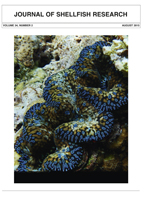Planting oyster cultch is a common management approach used to enhance recruitment. The two most popular cultch materials are shell and limestone. Both are sold by volume or weight; however, once deposited on oyster grounds, only a small portion of the total surface area of each particle is available for recruitment. Shell and limestone have different surface area to volume properties, and thus provide differential settlement opportunities. Exposed surface area to volume (expSA/V) ratios of oyster shell and limestone fragments were compared, as an indicator of their recruitment potential and cost-effectiveness for cultch planting. Samples were collected from the Primary Public Oyster Seed Grounds in Louisiana by vibracore, and from the Pass Christian TongingGrounds in Mississippi by dredge. Shell (including whole shell and fragments) and limestone particles greater than or equal to 8 mm by geometric shape were classified and their expSA/V was calculated. Mean expSA/V ratios of shell were approximately three to nine times higher than limestone. For limestone of similar particle size to provide an equivalent recruitment benefit for the same cost would require that the cost of purchase, transport, and planting be three to nine times lower than shell. Thus, shell is likely to be a more efficient material than limestone for recruitment enhancement. Nevertheless, the higher variability in expSA/V of shell and other factors such as the expected lifetime and the relative performance of small and large particles of materials should also be considered. Analysis of a Louisiana limestone plant and associated oyster cultch showed that the proportion of small and large limestone particles and the relative proportion of whole shells and fragments can greatly alter expSA/V. In this case, the a priori expectation that oyster shell would outperform limestone did not materialize because of the quantity of small limestone particles of favorable shapes in the deployed material. Even so, as yet unknown is the possible reduction in performance in situ of smaller particles that might occur if they increase the one-dimensionality of the plant.
How to translate text using browser tools
1 August 2015
The Exposed Surface Area to Volume Ratio: Is Shell More Efficient than Limestone in Promoting Oyster Recruitment?
Kelsey M. Kuykendall,
Paula Moreno,
Eric N. Powell,
Thomas M. Soniat,
Susan Colley,
Roger Mann,
Daphne M. Munroe
ACCESS THE FULL ARTICLE

Journal of Shellfish Research
Vol. 34 • No. 2
August 2015
Vol. 34 • No. 2
August 2015
cultch
limestone
oyster
recruitment
restoration
shell planting
surface area




